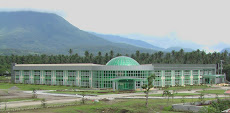Mr. President, distinguished colleagues:
Our country has been blessed with incomparable natural resources that are so biologically rich and diverse. Truly, if ecological wealth is the basis of power politics, we could have been a superpower. With our forests, watersheds, and bodies of water which house our exceptional flora and fauna, it is undisputable that the Philippines is indeed the “Pearl of the Pacific.” Or perhaps, it is more appropriate to say that the Philippines was once the Pearl of the Pacific. Because today the luster of the pearl is slowly perishing as people continue to ruin the gift of nature with their rapacious attitude and behavior.
Sadly, our natural resources are at the mercy of destructive human intervention. As the case may be for Mts. Banahaw- San Cristobal– the ‘holy mountain’ that did not escape the perils of human destruction. It seems that most people who visit the mountain, especially the huge number of devotees during Lenten Season, do not take special care to preserve the natural environment of the mountain. In fact, about 90 tons of garbage is collected from the mountains annually, contributing to the decline of the mountains’ ‘glory’.
In March 2004, its interim Protective Area Management Board (PAMB) temporarily closed certain parts of the mountain from the public for the next five years. Since then, there have been evident signs of restoration of its flora and fauna. The rafflesia, one of the biggest flowers in the world, started to reappear in the mountain. Just March of this year, it was also reported that the dried falls namely, Kristalino, Suplina and Salaming-Bubog, are now filled with flowing water.
But, the Philippine story is not limited to tales of environmental destruction and degradation because with sad tales come hope. Among others are the majestic and world renowned Tubbataha and Apo Reefs. As of today, the Tubbataha Reefs ranks number two (2) in the race to be recognized as one of the new seven (7) wonders of nature. Not far behind in its magnificence is the Apo Reef. The Apo Reef hosts the largest coral atoll-like reef in the Philippines, a sub-triangular coral atoll formation. Both of these reefs are considered as Key Biodiversity Area (KBA) in the country. These are only two of our country’s most prized natural gems.
With these tales of destruction and tales of hope, I therefore rise to seek your support for the passage of SB No. 2392 “an Act declaring Mountains of Banahaw and San Cristobal as a protected landscape” under CR No. 73, SB No. 2394 “an Act establishing the Tubbataha Reefs Natural Park” under CR No. 75 and SB No. 2393 “an Act establishing the Apo Reef Natural Park” under CR. No. 74.
Mts. Banahaw- San Cristobal
This covers 10,900 hectares spanning the provinces of Laguna and Quezon. It was declared a protected area by Presidential Proclamation 411 in 2003. Its rich biodiversity that demands our protection includes 578 animal species, 28% of which are categorized as endemic and 2% threatened with extinction, and 56 species of plants classified as endemic. The whole area is a critical watershed that drains into Laguna de Bay and Tayabas, supporting the Botocan Hydroelectric Power Plant in Majayjay and Luisiana, Laguna and sustaining the water needs of at least one million people. It is considered sacred ground by various religious sects.
Tubbataha Reefs National Park
In August 2006, Presidential Proclamation 1126 declared its reef area of 96,828 hectares as protected sanctuary of diverse marine life. Located within Central Sulu Sea, Tubbataha is under the municipal jurisdiction of Cagayancillo, Palawan. The reefs themselves are estimated to cover an area of 100 square kilometers, with the larger north reef measuring about 16 kilometers long and 4.5 kilometers wide and the south reef measuring about five kilometers long and three kilometers wide. The Tubbataha Reefs is regarded as one of the richest ecosystems on the planet. Researchers have recorded 396 species of corals- 85% of all hard coral species in the entire country. This 1993 UNESCO World Heritage Site and top SCUBA diving destination is also a RAMSAR site under the Ramsar Convention on Wetlands which identified it as “Extremely High” for marine biodiversity conservation.
Apo Reefs Natural Park
Located in Sablayan, Occidental Mindoro, this bio-geographic zone spans a core area of 15,792 hectares and a buffer zone of 11,677 hectares. Aside from its reef, it also has a mangrove forest and lagoon that provide the habitat of the endangered Nicobar Pigeon and a beach that serves as nesting areas of the likewise endangered Green Sea Turtle and Hawksbill Turtle. ARNP is one of the ten (10) Priority Sites under the Conservation of Priority Protected Area Project (CPPAP), a project funded under the World Bank. It also an important area for the conservation of biological diversity being rated as High for conservation priority area for reefs fishes and corals based on the results of the National Biodiversity Conservation Priority Setting Project undertaken by Protected Areas and Wildlife Bureau jointly with Conservation International and UP-CIDS.
Legislative Enactment
Mr. President, each of these three bills contain standard provisions patterned after the National Integrated Protected Areas System Act of 1992 or NIPAS act. However, the particular characteristics and peculiar level of protection needed to manage the three ecosystems are elucidated in each of these three bills. In particular, these bills provide the following elements necessary to achieve our utmost goal of biodiversity protection and preservation:
1. declaration of land classification, scope and boundaries;
2. creation of a Protected Area Management Board;
3. establishment of a Protected Area Fund;
4. identification of prohibited acts and their corresponding penalties.
In sum, these three bills underscore the imperative need to protect our God-given heritage before it is too late. These three bills gone through the hearing and technical working group process of the Committee on Environment and Natural Resources. There have also been extensive consultations with the Protected Areas and Wildlife Bureau of DENR and other concerned groups during the 13th and 14th Congress.
Conclusion
Mr. President, let us continue the job that Congress set forth with NIPAS in 1992 which is to protect the environment, conserve resources and restore the habitat. By establishing additional urgent protected areas around the country, we conserve the uniqueness of a site’s biological and physical features and foster partnership between government, non-government and people’s organizations to preserve ecosystems in their natural state.
Mr. President, we cannot wait for Mts. Banahaw- San Cristobal to be vulnerable again to destruction as the PAMB’s safeguard lapses in the coming year. Nor can we wait for Tubbataha Reefs and Apo Reefs to remain at risk of environmental devastation. If we allow such, we do not only allow the tragic death of these precious gifts of nature but we also, as legislators, go against our sworn duty to look after the best interest of our people and go against, as stewards of nature, our primary responsibility to ensure the protection and conservation of nature for our future generation.
They need our legislative intervention. Let us not deprive Mts. Banahaw and San Cristobal the opportunity to regain its glory or the Tubbataha and Apo Reefs’ opportunity to maintain its glory. It is crucial that we act NOW on these to ensure that our children and the succeeding generations will inherit a living earth with all of its bountiful natural resources and vibrant wildlife. Let us not deprive our future generation from waking up to these wonders or wait for the day that all we have are memories of the beauty that was.
Once again, I rise to seek your support for the passage of Senate Bill Nos. 2392 under CR No. 73, 2394 under CR No. 75, and 2393 under CR. No. 74. By voting to approve these three bills, we cast a vote for the future today.
Thank You.
Sunday, August 9, 2009
Subscribe to:
Post Comments (Atom)







No comments:
Post a Comment